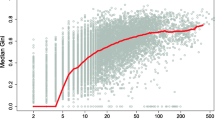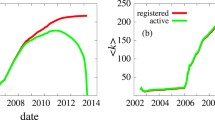Abstract
Friendster is a social networking service which used to be popular at the beginning of the twenty-first century. Some analysis implies that the user network on Friendster collapsed from the “outside” of the layered structure of the cores. However, it is still not clear if the network really collapsed from the outside. We analyze the time evolution of the network structure more exactly to check whether that is true. It is shown that the collapse of the Friendster network actually started from the “center” of the core structure. Following this result, we attempt to explain its mechanism by a propagation model. We conclude that the time evolution of core structure can be explained by the two rules: (a) non-users who have many friends on Friendster are likely to register for Friendster, and (b) users who have many friends that have already left Friendster are also likely to leave. The users who have few friends on Friendster tend to leave soon and that may have also played a key role in the time evolution of the core structure. Moreover, under the assumption that our model is valid, we discuss what to do to prevent the decline of online communities. First, it is not effective to promote registration in maintaining the number of active users. Second, it is effective to promote non-active users to become active again. Third, it is effective to persuade influential users preferentially when we assume that the chain reaction of coming back may occur.































Similar content being viewed by others
Notes
Similar phenomenon is observed on the user network on Twitter (Garcia et al. 2016). The probability of becoming inactive basically decreases as coreness increases when coreness is not so large, but it begins to increase thereafter. This implies that, in some cases, users at the center of the core are more likely to leave. They explained this phenomenon by information overloads and negative effects on attention.
References
Akiba T, Iwata Y, Yoshida Y (2013) Linear-time enumeration of maximal k-edge-connected subgraphs in large networks by random contraction. In: Proceedings of the 22nd ACM international conference on information & knowledge management. ACM, pp 909–918
Andrews DC (2002) Audience-specific online community design. Commun ACM 45(4):64–68
Backstrom L, Huttenlocher D, Kleinberg J, Lan X (2006) Group formation in large social networks: Membership, growth, and evolution. In: Proceedings of the 12th ACM SIGKDD international conference on knowledge discovery and data mining. ACM, pp 44–54
Barabási AL, Albert R (1999) Emergence of scaling in random networks. Science 286(5439):509–512
Bauckhage C, Kersting K (2014) Strong regularities in growth and decline of popularity of social media services. arXiv preprint arXiv:14066529
Bianconi G, Darst RK, Iacovacci J, Fortunato S (2014) Triadic closure as a basic generating mechanism of communities in complex networks. Phys Rev E 90(4):042806
Cannarella J, Spechler JA (2014) Epidemiological modeling of online social network dynamics. arXiv preprint arXiv:14014208
Cazabet R, Amblard F, Hanachi C (2010) Detection of overlapping communities in dynamical social networks. In: 2010 IEEE 2nd international conference on social computing. IEEE, pp 309–314
Centola D (2010) The spread of behavior in an online social network experiment. Science 329(5996):1194–1197
Chen Y, Kawadia V, Urgaonkar R (2013) Detecting overlapping temporal community structure in time-evolving networks. arXiv preprint arXiv:13037226
Cooley C (1909) Social organization: a study of the larger mind. Scribners, New York
Ellison NB et al (2007) Social network sites: definition, history, and scholarship. J Comput Mediat Commun 13(1):210–230
Fortunato S, Castellano C (2012) Community structure in graphs. In: Meyers RA (ed) Computational complexity. Springer, Berlin, pp 490–512
Garcia D, Mavrodiev P, Schweitzer F (2013) Social resilience in online communities: the autopsy of friendster. In: Proceedings of the 1st ACM conference on online social networks. ACM, pp 39–50
Garcia D, Mavrodiev P, Casati D, Schweitzer F (2016) Understanding popularity, reputation, and social influence in the twitter society. Center for Open Science, Charlottesville, Virginia
Granovetter MS (1973) The strength of weak ties. Am J Sociol 78(6):1360–1380
Harkins A (2013) Network games with perfect complements. Warwick University Draft, unpublished
Hethcote HW (2000) The mathematics of infectious diseases. SIAM Rev 42(4):599–653
Hillery GA (1982) A research odyssey: developing and testing a community theory. Transaction, Piscataway, New Jersey
Iñiguez G, Kertész J, Kaski KK, Barrio RA (2009) Opinion and community formation in coevolving networks. Phys Rev E 80(6):066,119
InternetArchive (2011) Friendster social network dataset: friends. https://archive.org/details/friendster-dataset-201107
Iriberri A, Leroy G (2009) A life-cycle perspective on online community success. ACM Comput Surv (CSUR) 41(2):11
Jo HH, Pan RK, Kaski K (2011) Emergence of bursts and communities in evolving weighted networks. PLoS ONE 6(8):e22687
Kairam SR, Wang DJ, Leskovec J (2012) The life and death of online groups: predicting group growth and longevity. In: Proceedings of the 5th ACM international conference on web search and data mining. ACM, pp 673–682
Kermack WO, McKendrick AG (1927) A contribution to the mathematical theory of epidemics. Proc R Soc Lond A Math Phys Eng Sci 115:700–721
Kitsak M, Gallos LK, Havlin S, Liljeros F, Muchnik L, Stanley HE, Makse HA (2010) Identification of influential spreaders in complex networks. Nat Phys 6(11):888–893
Kumar R, Novak J, Tomkins A (2010) Structure and evolution of online social networks. In: Yu PS, Han J, Faloutsos C (eds) Link mining: models, algorithms, and applications. Springer, Berlin, pp 337–357
Kumpula JM, Onnela JP, Saramäki J, Kaski K, Kertész J (2007) Emergence of communities in weighted networks. Phys Rev Lett 99(22):228,701
Laurent G, Saramäki J, Karsai M (2015) From calls to communities: a model for time-varying social networks. Eur Phys J B 88(11):1–10
Ling LW (2008) Friendster moves to Asia. http://content.time.com/time/business/article/0,8599,1707760,00.html
Liu H, Nazir A, Joung J, Chuah CN (2013) Modeling/predicting the evolution trend of osn-based applications. In: Proceedings of the 22nd international conference on world wide web. ACM, pp 771–780
MacIver R (1917) Community, a sociological study: being an attempt to set out the nature and fundamental laws of social life. Macmillan, London
Marceau V, Noël PA, Hébert-Dufresne L, Allard A, Dubé LJ (2010) Adaptive networks: coevolution of disease and topology. Phys Rev E 82(3):036116
Newman M (2010) Networks: an introduction. Oxford University Press, Oxford
Palla G, Barabási AL, Vicsek T (2007) Quantifying social group evolution. Nature 446(7136):664–667
Patil A, Liu J, Gao J (2013) Predicting group stability in online social networks. In: Proceedings of the 22nd international conference on world wide web. ACM, pp 1021–1030
Qiu J, Li Y, Tang J, Lu Z, Ye H, Chen B, Yang Q, Hopcroft JE (2016) The lifecycle and cascade of wechat social messaging groups. In: Proceedings of the 25th international conference on world wide web. International World Wide Web Conferences Steering Committee, pp 311–320
Ribeiro B (2014) Modeling and predicting the growth and death of membership-based websites. In: Proceedings of the 23rd international conference on world wide web. ACM, pp 653–664
Ribeiro B, Faloutsos C (2015) Modeling website popularity competition in the attention-activity marketplace. In: Proceedings of the 8th ACM international conference on web search and data mining. ACM, pp 389–398
Richard M (2013) The online community lifecycle. https://www.feverbee.com/the-online-community-lifecycle/
Rivlin G (2011) Wallflower at the web party. http://www.nytimes.com/2006/10/15/business/yourmoney/15friend.html
Rogers E (2003) Diffusion of innovations, 5th edn. Free Press, New York
Schneider A, Von Krogh G, JäGer P (2013) Whats coming next? Epistemic curiosity and lurking behavior in online communities. Comput Hum Behav 29(1):293–303
Seki K, Nakamura M (2016) The collapse of friendster network started from the center of the core. In: Proceedings of the 2016 IEEE/ACM international conference on advances in social networks analysis and mining. IEEE, pp 477–484
Toivonen R, Onnela JP, Saramäki J, Hyvönen J, Kaski K (2006) A model for social networks. Phys A 371(2):851–860
Tönnies F (1887) Community and society. In: Lin J, Mele C (eds) The urban sociology reader, vol 13. Routledge, London
Torkjazi M, Rejaie R, Inger W (2009) Hot today, gone tomorrow: On the migration of myspace users. In: Proceedings of the 2nd ACM workshop on online social networks. ACM, pp 43–48
Vardhan H (2015) Platform failures: lessons for strategic management. Ph.D. thesis, Massachusetts Institute of Technology
Viswanath B, Mislove A, Cha M, Gummadi KP (2009) On the evolution of user interaction in facebook. In: Proceedings of the 2nd ACM workshop on online social networks. ACM, pp 37–42
Wilkinson D, Thelwall M (2010) Social network site changes over time: the case of myspace. J Am Soc Inf Sci Technol 61(11):2311–2323
Wilson C, Boe B, Sala A, Puttaswamy KP, Zhao BY (2009) User interactions in social networks and their implications. In: Proceedings of the 4th ACM European conference on computer systems. ACM, pp 205–218
Wu S, Das Sarma A, Fabrikant A, Lattanzi S, Tomkins A (2013) Arrival and departure dynamics in social networks. In: Proceedings of the 6th ACM international conference on web search and data mining. ACM, pp 233–242
Yu Y, Xiao G, Zhou J, Wang Y, Wang Z, Kurths J, Schellnhuber HJ (2016) System crash as dynamics of complex networks. Proc Natl Acad Sci U S A 113(42):11726–11731
Zuev K, Boguñá M, Bianconi G, Krioukov D (2015) Emergence of soft communities from geometric preferential attachment. Sci Rep 5(1):9421
Author information
Authors and Affiliations
Corresponding author
Rights and permissions
About this article
Cite this article
Seki, K., Nakamura, M. The mechanism of collapse of the Friendster network: What can we learn from the core structure of Friendster?. Soc. Netw. Anal. Min. 7, 10 (2017). https://doi.org/10.1007/s13278-017-0429-2
Received:
Revised:
Accepted:
Published:
DOI: https://doi.org/10.1007/s13278-017-0429-2




